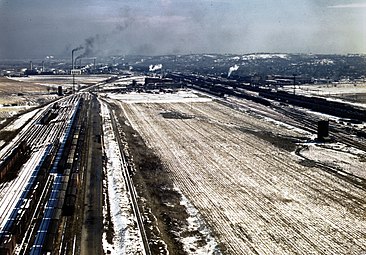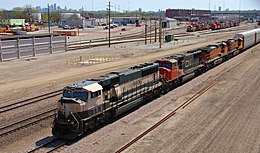Argentine Yard
| Argentine Yard | |
|---|---|
|
Aerial view of the marshalling yard from 2016, looking south |
|
| Data | |
| Operating point type | Marshalling yard |
| Design | Through station |
| opening | 1890 |
| location | |
| Place / district | Kansas City (Kansas) |
| State | Kansas |
| Country | United States |
| Coordinates | 39 ° 5 '4 " N , 94 ° 41' 12" W |
| List of train stations in the United States | |
The Argentine Yard is a shunting yard of the BNSF Railway in Kansas City, Kansas . With 60 direction tracks and an area of over 3 km², it is the largest marshalling yard in the BNSF network. It is located between the Kansas River in the north and the eponymous district Argentine of Kansas City (Kansas) in the south, about ten kilometers west of downtown Kansas City, Missouri .
The Argentine Yard is one of several large marshalling yards in the metropolitan area of Kansas City , which are operated in addition to the BNSF by the Union Pacific , the Norfolk Southern and the Kansas City Southern . Greater Kansas City is the largest rail hub in the United States in terms of freight volume ; Over 300 freight trains arrive or leave the metropolitan region every day (2016).
history
From 1875 the Atchison, Topeka and Santa Fe Railway (AT&SF) built the first railway facilities with warehouses and workshops in Argentine, which were expanded to a passenger, freight and marshalling yard with track systems of over 40 km in length by 1890. As at many other freight stations in the Midwest , AT&SF also built a grain elevator with a large silo complex. Due to the increasing mechanization of agriculture , the handling volume of grain rose sharply in the 1920s, which made it necessary to expand the capacity of the complex from the original 1 million bushels to over 10 million bushels (about 350,000 m³), with the second largest plant in originated in the USA; it was operated by the tenant Davis-Noland-Merrill Grain Company .
From the end of the 1940s, the Argentine Yard was expanded several times and, by the end of the 1960s, it was rebuilt as the central hub of AT&SF with two large marshalling yards for goods transport to the west (westbound) and east (eastbound) . With railway tracks of over 350 km in length and a capacity of nearly 15,000 wagons were at peak hours daily over 6,000 car here ranks are. AT&SF employed between 2,000 and 3,000 people on the site in the 20th century and was the largest employer in Argentina. In 1995 AT&SF merged with the Burlington Northern Railroad (BN) to form the Burlington Northern Santa Fe Railway ( BNSF Railway ), which demolished the silo complex in 1996 and completely rebuilt and modernized the marshalling yard by 1997.
The grain elevator with silo complex 1943, capacity 10 million bushels (about 350,000 m³)
Today's plant
Today's flat station has ten entry and ten exit tracks as well as 60 directional tracks of up to 2.5 km in length in the directional harp . Around 4 trolleys per minute can be maneuvered with a theoretical maximum throughput of 5,760 trolleys per day. During the modernization, the BNSF also had Dowty retarders installed as gradient compensation brakes for the first time . In addition, since the mid-1950s there has been a depot on the east side for maintaining the shunting locomotives . With the Murray Yard in North Kansas City, the BNSF operates another marshalling yard (formerly Burlington Northern ), which is connected to the Argentine Yard via the Hannibal Bridge (1917) and ASB Bridge (1911) and by tracks along the Kansas River . The east-west connection of the BNSF runs in the greater Kansas City area over tracks of the Kansas City Terminal Railway (KCTR), including since 2004 over the Argentine Connection Bridge located five kilometers east of the marshalling yard .
See also
- List of marshalling yards
- BNSF Railway marshalling yards: Barstow Yard , Corwith Yard , Galesburg Yard , Northtown Yard
Web links
- View of Argentine Rail Yard in Kansas City, Kansas. Kansas City Aerial Photographs, The University of Kansas.
Individual evidence
- ↑ Chris Bodenner: Orbital View: A Massive Rail Yard. In: The Atlantic. December 12, 2015, accessed September 7, 2018.
- ^ Steve Lowery: Top Cities for Global Trade. In: Global Trade. September 27, 2016, accessed September 7, 2018.
- ^ A b Edwin Dale Shutt, II: "SILVER CITY," A History of the Argentine Community of Kansas City, Kansas. Master of Arts Thesis, Emporia Kansas State College, 1974, p. 21 and 174-178 ( online ).
- ↑ Santa Fe Speeds Up Wheat Movement. In: Railway Age. Vol. 85, No. 20, 1928, pp. 961–964 ( limited preview in Google book search).
- ^ The Handling and Storage of Our Huge Grain Corp. In: Scientific American. Vol. 101, December 11, 1909, p. 444.
- ^ Greg A. Hoots: Flint Hills. MBI Publishing, 2003, ISBN 978-0-7385-8313-6 , p. 94.
- ^ A b Michael Rhodes: North American Railyards. Arcadia Publishing, 2011, ISBN 0-7603-1578-7 , pp. 24-29.







